If you are like me, when winter begins to fade, my enthusiasm for early spring harvesting is high.
I cover myself well to avoid the mischief of ticks and insects, grab my basket, put a knife in it and a pair of kitchen scissors. Wearing a pair of gardening gloves off I go, searching for a foraging feast!
First I focus on procuring greens (and edible flowers). Then I march on to collect tubers, and lastly, I try to find items with different flavors to complete the meal.
Violets (Viola Spp.)
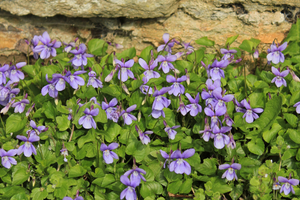 Violet flowers grow from the Mississippi up to the Canadian border in the Northern US.
Violet flowers grow from the Mississippi up to the Canadian border in the Northern US.
The familiar blue or purple violet has serrated, heart-shaped leaves.
They are found along the fringes of the lawn or beneath trees in shady areas.
You may not have to look further for this herb than your backyard – how convenient!
Related: 10 Reasons Why You Need to Make Room for the God of Fungi in Your Backyard
Violets are high in vitamins C, A, and E. You can gather the leaves and the flowers in spring to add to your salad. The leaves can also go into the recipe in this article for Wild Greens stir fry.
Only forage this plant when it is in bloom. Otherwise, you may confuse the greens with other leaves that are not edible.
Sheep Sorrel (Rumex acetoscella)
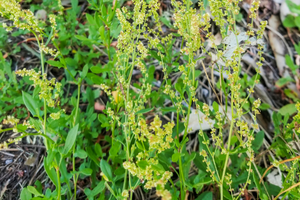 Sheep Sorrel is a lettuce substitute.
Sheep Sorrel is a lettuce substitute.
Located throughout the United States, it has thick, pointed succulent leaves with a tapered tip, fashioned into pointed basal lobes.
You will find it in wastelands, wooded margins, and gardens in the spring.
Chop a cup or so and put it into a salad. Sheep Sorrel is high in oxalic acid so don’t consume more than a cup per day.
Nettle (Urtica Dioica)
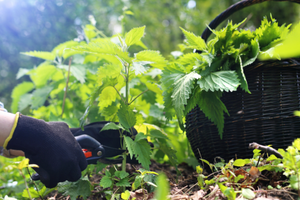 Nettles thrive in the sun to part shade.
Nettles thrive in the sun to part shade.
They prefer damp, wooded areas with rich soil or moist beds near water.
Young, springtime nettle leaves are consumed right from the plant after removing the sticker.
Related: How to Cook Spring Nettles
If you gather enough of them, you can add them to a salad like spinach.
Nettles are a superfood containing minerals, calcium, magnesium, potassium, iron, phosphorus, manganese, silica, vitamins C, B vitamins, and chlorophyll.
You must remove the stickers from the leaves and stems before consumption and always wear gloves when harvesting this herb. Please do not consume more than two tablespoons of this herb daily.
Nettles are a strong detoxifying herb. Detoxifying too quickly or without drinking enough water may cause a headache or nausea.
Red Clover (Trifolium Pratense)
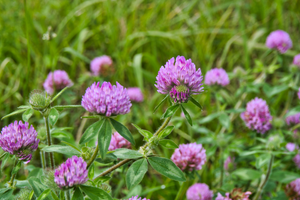 Start gathering Red Clover flowers and leaves in early spring.
Start gathering Red Clover flowers and leaves in early spring.
The plants grow close to the ground, with three leaflets that have a pale green stripe up the center.
The flower head is a rose-purple globe with tiny petals.
You will find it in sunny, open fields and meadows or sunny spots in your lawn or garden.
Incredibly rich in nutrients, Red Clover contains calcium, chromium, magnesium, niacin, phosphorus, potassium, thiamine, and vitamin C.
Purple Dead Nettle (Lamium Purpureum)
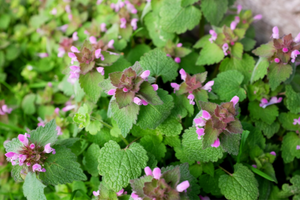 Another variety of nettle that is easy to find in the spring is Purple Dead Nettle.
Another variety of nettle that is easy to find in the spring is Purple Dead Nettle.
It grows in the early to mid spring.
You will find these common clumps of heart-shaped edible leaves, serrated around the edges in part sun to shade fields, meadows and gardens.
In a circular fashion, the light green to purplish leaves the flowers grow, then there is a stem space and then a row of singular pink to purplish tubular flowers.
Use the leaves, flowers or stems in salads, soups, stews, casseroles or egg dishes. Purple Dead Nettle is not quite as strong as other nettle varieties but it is still a good idea to follow the contraindications.
How To Make Wild Greens Stir Fry
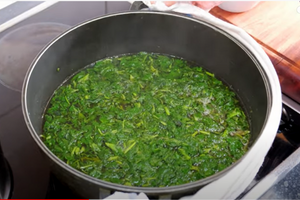 – 1 cups of finely chopped nettle leaves
– 1 cups of finely chopped nettle leaves
– 1 cup of mixed wild greens
– 1 cup of finely chopped green cabbage
– 3 chopped edible mushrooms
– 1 clove of diced wild garlic
– 1 tablespoon of grated ginger root
– 2 tablespoons of sesame oil
-1 tablespoon lemon juice (add ¼ teaspoon of lemon zest if desired)
Sauté the mushrooms first for 15 minutes. Add the garlic, and ginger and cook for five minutes. Add the chopped greens at the end and toss for another five minutes.
Chickweed (Stellaria Media)
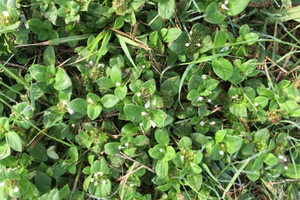 Chickweed can grow in your lawn during the early days of spring.
Chickweed can grow in your lawn during the early days of spring.
It thrives in mild climates yet can grow year-round.
Chickweed has a shallow root system and spreads rapidly. The stem is prostrate with multiple branches.
It is straggly, usually four to six inches long, and its leaves are small, opposite, oval, and flat with hairy petals. Its flowers are very white and small with a deep cleft, plus two parted petals.
You can think of Chickweed as wild lettuce. Parts used include leaves, flowers, and stems. Pick, wash and consume the aerial parts directly like lettuce and add them to sandwiches and salads.
How To Make Chickweed Stew
- Pick your favorite poultry, rabbit, or beef.
- Stew the meat as normal until it is tender.
- One-half hour before the meat is done add four chopped cups of Chickweed, one chopped potato, and two chopped carrots. Mix the ingredients and cover with water.
- Continue to stew for one-half hour. Cool and serve.
Fiddlehead Fern (Atherium Filix-femina)
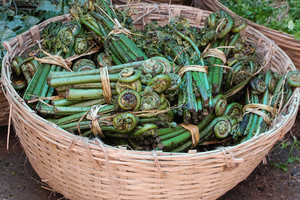 Throughout the temperate Northern hemisphere you’ll find fiddleheads, curled up in damp, shaded forest areas waiting to give you their benefits.
Throughout the temperate Northern hemisphere you’ll find fiddleheads, curled up in damp, shaded forest areas waiting to give you their benefits.
They store nutrients copper, vitamins B3, C and A plus Manganese. They enhance immunity, decrease inflammation, and help build bone strength.
Related: 15 Common Wild Plants You Never Thought Were Edible
Pick the curl before it has matured and the leaves begin to show. Wash them well, the stems and heads are hairy, and sauté them (or eat them raw if you desire a very unique taste.
I recommend finding some Red Clover flowers and adding them to your sautéed fiddleheads. It makes an attractive and healthy combination.
Dandelion (Taraxacum Officinale)
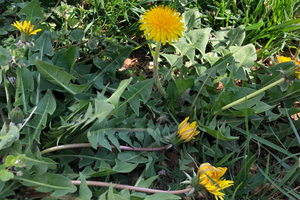 Any northeastern landscape without Dandelion seems unimaginable.
Any northeastern landscape without Dandelion seems unimaginable.
You find it on lawns, between cracks in the driveway, and in rocky areas with poor quality soil.
It is a highly nutritional herb, rich in vitamins A, C, B1, potassium, and minerals.
You can make an entire dinner with this plant! Pick the leaves and eat them fresh after washing, or put them in a salad.
Fry the flowers after you dip them in pancake batter to make a fritter. Last but not least, steep one tablespoon of the fresh roasted root in a quart of water, strain, and drink as a coffee substitute.
Contraindications: This is a diuretic. Take note that it can cause loose stools in the process of detoxification or diarrhea if it is overused.
Wild Asparagus (Asparagus Officianalis)
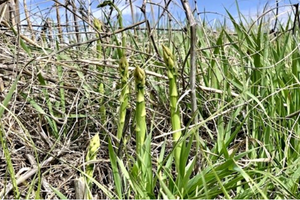 The light green spikes emerge in the early spring along roadsides and fence rows.
The light green spikes emerge in the early spring along roadsides and fence rows.
The easiest time to spot the plant is when the tall feathery adult plants rise up to three feet tall and have small, red berries attached. Parts used however are the spring spikes.
Consume just as you would regular asparagus. I like to chop mine up and put it into a quiche. Another option is to make an asparagus tortilla.
Wild Asparagus Tacos
- Cook the tortilla for less than a minute on either side.
- Add some shredded cheese (optional).
- Take it out of the pan and add some chopped wild greens.
- Lightly poach the asparagus spears until they are soft and an even brighter green.
- Roll them up in the tortilla.
Groundnuts (Apios Americana)
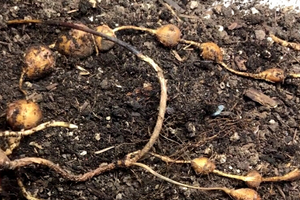 Groundnuts grow throughout the entire US except for southern California and lower Florida.
Groundnuts grow throughout the entire US except for southern California and lower Florida.
They climb, like a pea vine and have multiple tubers along the length of the root.
The leaves are compound, and feather-like.
You will find them on the edges of streams, bogs and thickets. Parts used include the seeds and tubers.
Related: How To Harvest These Seeds For SHTF
The younger tubers that are not so thick skinned taste the best. Cook them in the same way as a lentil bean or a potato. These tubers also make a perfect potato substitute and contain an astonishing 15 percent protein. You can peel and roast them along with your wild garlic.
Do not eat them raw. Raw groundnuts interfere with protein metabolism. Always cook groundnuts.
Jerusalem Artichoke (Helianthus Tuberosus)
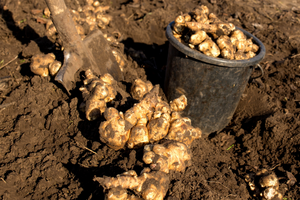 Another tuber you can harvest during the spring is Jerusalem Artichoke.
Another tuber you can harvest during the spring is Jerusalem Artichoke.
The edible tubers are at the end of dried stalks leftover from last winter. You might have noticed the yellow daisies growing last summer, up to 20 feet high. Pull the stalk gently and you may find one or two tubers.
Underneath however, if you dig the tubers are in clusters and are quite plentiful. You can roast or cream them just like a normal potato.
You must wash these extremely well. I wash mine after soaking them and at the end I scrub them all over with a toothbrush.
Spicebush (Lindera Benzoin)
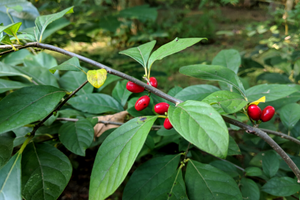 Look for this shrub in the early spring in rich woodlands and along streams.
Look for this shrub in the early spring in rich woodlands and along streams.
It may grow up to fifteen feet tall with multiple spreading branches.
The key is the smell. The smooth branches give off a spicy odor when you scratch them with your fingernail.
Leaves are light green, smooth and small and pointed. Parts used include the bark, twigs and the berries.
Related: If You See This Berry, You May Want To Harvest It
Collect a handful of short twigs. Cut and tie them together and drop them into any stew to add a flavor similar to allspice. Dry and grind the berries into a powder to add to your spice breads or pumpkin pie just like allspice.
Garlic Mustard (Alliaria Petiolata)
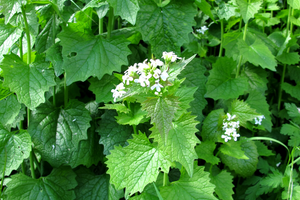 Garlic Mustard is very easy to find and is one of the first herbs of spring.
Garlic Mustard is very easy to find and is one of the first herbs of spring.
It grows prolifically in lowland woody areas in either shade or part sun.
The long sturdy stems rise upwards with triangular to heart-shaped, serrated, edible leaves that are soft to touch.
The greens grow for three weeks before tiny clusters of white flowers emerge from the juncture of the stem and leaf. Parts used include the aerial parts, leaves, stems (the young and tender ones), and flowers.
This herb is an excellent source of Vitamin C. It contains 190 mg of Vitamin C per 100 grams. Like Chickweed, you can spice up a salad or sandwich with them.
This herb should not be used by those with thyroid conditions because it makes iodine levels slightly fluctuate. For most, however, it is perfectly healthy.
How To Make Garlic Mustard Pesto
- Combine a cup of chopped garlic mustard leaves with one tablespoon of chopped onion, ¼ cup of parmesan cheese, and ¼ cup olive oil.
- Blend well in your mixer. Add a little water if required.
- Use as a sandwich spread or with any pasta or grain.
Wild Garlic (Allium Sativum)
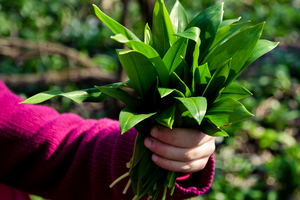 Wild garlic and onion generally grow in the eastern half of the U.S..
Wild garlic and onion generally grow in the eastern half of the U.S..
Long narrow pencil-like stalk bulbs grow in clusters beneath the dirt attached to the stalks.
You can consume wild garlic in the same ways you would consume a regular bulb of garlic.
Wild garlic is delicious roasted. Cover it with olive oil and roast on a cookie sheet at 350 degrees for 10 minutes. Sprinkle it with salt and pepper and close the oven door. Leave the garlic in the over until the heat dissipates, then serve.
Oyster Mushrooms (Pleurotus Ostreatus)
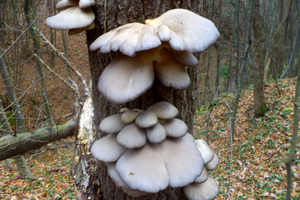 Following an early spring rainstorm, as the temperature rises, search for decaying aspen trees.
Following an early spring rainstorm, as the temperature rises, search for decaying aspen trees.
The Oyster mushroom grows in a light to golden yellow, white or golden bunch on a dead beech or aspen tree.
It fans out layer by layer feeding off of the aspen tree.
The gills are whitish to yellowish and mature caps grow up to fifteen inches. In the spring they will be much smaller.
You must know exactly which mushroom you are harvesting. Check with a couple of trusted sources before consuming. Also, wild mushrooms should be cooked for twenty-five minutes before eating.
The next time the sun comes out, prepare for an adventure outdoors and a forager’s feast with these recipes! I can guarantee that you won’t regret it.
You may also like:
 Some Firearm Tips for New Preppers and/or Those Who are New to Firearms
Some Firearm Tips for New Preppers and/or Those Who are New to Firearms
How To Make Wild Bread (With Dandelions) (Video)

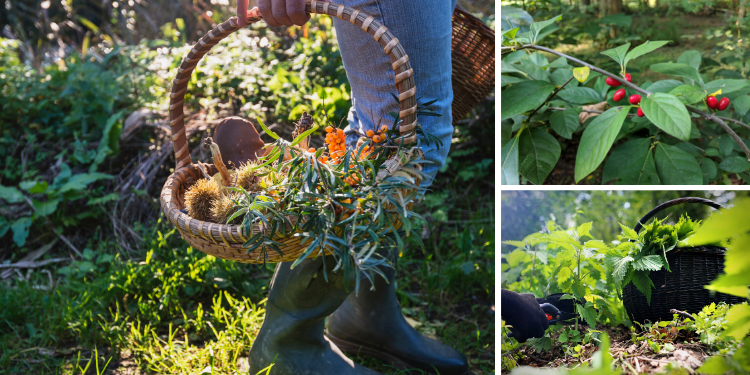













The way that things are going learning to forage is a good idea.
Approximately thirty million chickens have been killed due to the
avian influenza.Most were layIng hens.
This has already led to a serious shortage of pasta.
I agree with you. We lost two-thirds of a deer herd that grazes on the property due to a virus. In the midst of uncertainty foraging helps you feel confident.
Nettles in salad? I don’t think so–too much trouble to remove the hairs. However–the sting disappears once the leaves are either dried (for tea or later cooking) or boiled. *Much* easier that way. It makes a wonderful cooked green–cook it like spinach. I’ve more than once passed off creamed nettles as creamed spinach! Have to say I never heard of limiting to a couple tablespoons per day, either–we’ve always enjoyed a good helping!
While walking through a Northwest coastal forest, my niece reached over and picked a nettle leaf. She folded it carefully into a tiny little square, the size of her molar, and chomped down on it. That broke down all the little hairs and she ate it with no sensations from the stinging hairs.
Another relative would pick the best of the young spring time leaves and keep them fresh for a couple of weeks in the fridge between wet folded paper towels. She would then have a cup of nettle tea each morning. She believed that it was healthiest to have first thing, before coffee or anything else.
I now live where there are no nettles. I sure miss having the springtime nettle soup or just cooked like spinach.
Thank you, I really like the creamed nettle leaf idea. I will try that.
One of our favorite things to find in the spring time is wild morel mushrooms.
We cook them like cooking a chicken fried steak.
Dip in egg, flour and cornmeal and then fry…mmm…mmm good!!
Mail pouch,
I am stealing that recipe!! Sounds excellent. Might be a way to get the Grandbiys to eat them. OH, maybe not, then I’d have to share them, lol.
Thanks for posting it.
Peace,
MadFab
Sounds delicious! Thank you for sharing.
Has anyone else here heard about “potato and tomato poisons”? Here is the link https://www.doctorkiltz.com/glycoalkaloid-potato-poison/
Well I have been eating potaotes and tomatoes for 70 years.I have eaten them cooked and raw. I have yet to have any of those symptoms. When I was young we had potaoes and tomatoes almost every meal because that was what we had more of. I am not saying they don’t have those toxins but it has been long said everything you eat harms you in some way. That is the reason for varied diets. Not eating to much of any one thing is what you are supposed to do. To much meat hurts you, to many vegatables hurts you, to many sweets hurts you and to many fruits hurt you.
So vary your diets this does two things first it gives you better tasting food because eating the same thing gets boring and second you get all the vitamins and nutrients your body needs because each food has its own types of vitamins and nutrients.
Dreaded: And then there’s the awful aqua poisoning, and the ever deadly oxygen poisoning! As the late, great Rush Limbaugh warned us, Eat 1 carrot–Just one! you gonna die. I must accept the inevitable, death by carrot. I still like carrots and eat all the ripe tomatoes I can pry out of the garden. Potatoes, grew up on them, but carbs are not a friend. Not that I would turn down french fries, fried potatoes, potato and hot dog soup, and a few other delicacies if someone made them. And then there’s other toxins I was raised with and still eat, deep fried fat, fried ham fat, beef tallow, lard. I have a bro, an Aleut Indian, who made the best sweet lard you ever! No, I’m not planning to live forever. Damnible toxic carrots… 🙂 niio
Easyrider: She sounds like a spoiler to me. What about gluten in grain? That kills thousands each year, usually by causing uncontrollable diabetes. Aflatoxins in grain, legumes, and peanuts kill a lot of people each year. In short, ain’t no pure nothing. you breathe in toxins, drink them, eat them, absorb them thru your skin and eyes. Your body fights them off and often is stronger thanks to them. Too much at one time may kill, but we eat it all day long. Don’t allow people like this to spoil life. niio
With potatoes sometimes stored exposed to light, the green effect of the toxins is valid. It may be that some people are more susceptible than others as I can taste it, if prepared potatoes have green on them but others I know are not bothered.
The same can be said for tomatoes. One of my favorite things used to be eating cherry tomatoes off the vine after they have been warmed by the sun. Unfortunately, last year I developed an allergy to tomatoes and have had to eliminate them from my diet.
A relative of mine has an onion allergy that includes all alliums, even aloe vera in skin care products. Fortunately, they have a freeze dryer so that they have been able to prepare long time storage mixes without any alliums in them.
Like Dreaded I have been eating every one of the listed poisonous foods, but for 86 years. We always knocked off the sprouts and usually pealed the spuds. If mostly green threw out where hogs and cows would not get them.
Thank you for this article. I have been trying to get out to forage a bit this spring. Only a Novice, but trying to gain more knowledge.
I know fiddleheads nettles morels and of course dandelions.
Got a couple books from the library, but either bad photos or not for this area of the PNW.
Anyone know of a good book with lots of photos for Northern Western Washington?
I liked that the author gave some recipes, also. That was a bonus.
Chuck, I totally agree with ya about the chickens. Between the bogus PCR tests, the same type used for the Covid disaster, and complete disregard for science, our government is doing its best to starve us out!!
Fred Meyers here have whole chickens for 13.00!!! WTH!!
Went to Walmart and got 10#bags of leg quarters for 68 cents a pound. Processed them yesterday and froze them.
My chickens are fortunately revving up and thinking of getting a few more, but Co Op gets chick’s in the am and are gone by end of day! Sounds like some more folks are wising up or maybe just those who have their heads out of their phones are just getting more. The problem is feed prices. Wow has that been a shock. I have about a years worth but always want to keep adding.
As to pasta making. You can use powdered eggs and just a bit of oil to make pasta. My grandboys can’t tell the difference,, but they usually inhale it so not sure they are tasting it! Lol
Ok I am rambling now.
Michael, haven’t seen ya on for a couple days. All ok?. He who shall not be named is quite worried. Said his friends in business say the warehouses have about q month left and NO where to get more.
Come to think of it haven’t seen Armin and LCC, either. Hoping all is well with all. Prayers and blessings to all.
Peace
MadFab
Hello MadFab 🙂 Glad to see you too. Doing well enough, feeling my age as prepping the expanded gardens. I suspect a bag of fresh onions and potatoes will be pretty good to share this fall.
Saw something about OH’s comments (He who cannot be named, indeed) and that sounded pretty harsh. So far, I’ve been unable to confirm nor deny his comment. Have you a second reference?
Locally the normies are starting to notice something. A lot less of the old storage stuff (dry beans-rice, etc.) has been on the two Walmart’s nearby I noticed two days ago. Normally those 8 pound bags of pintos needed DUSTING but now seem gone. IF this follows the COVID TP situation it was plenty of TP, day 2 TP a bit scarce, day 3 Looking for TP on Ebay. Herd tends to herd.
Have you tried to make pasta without eggs? Some folks find the stubby types (not spaghetti) do well enough with just flour and water. Some recipes I’ve not tried use plain yogurt or the Aquafina from canned chickpeas as a liquid and binder for pasta. I know my German Grandmother in midwinter would make Spätzle as eggs were hard to come by.
That reminds me I need to grow a chickpea patch, that reminded me of several chickpea references lately. Coarsely ground and mixed 25% to 75% corn-wheat is an old scientific farmers laying feed (Pre-Purina). Most of the bean-field peas were also used but kidney beans needed cooking first. Chickens also enjoy many root crops (potatoes, turnups, rape, beets, mangles) but protein is low and they NEED around 16% to lay eggs and grow out. Most of that grow very well out your way. You also can feed trapped predators and road kill to chickens, BUT you need to cut them open-or in half so they can get there. Just saying.
Northwest Foraging: The Classic Guide to Edible Plants of the Pacific Northwest is one I’ve heard good reports on. It’s set up in seasons to search and how to preserve them for later use. Not an expensive book.
Michael,
Boy I hear ya about feeling your age!! I’m much to young to feel this damn old, to quote Garth Brooks. Lol
Been working in garden and greenhouse. Also my oldest Grandboy is turning 13 next week so we are having his Bar Mitzvah on Sunday, so that is a bit crazy making. Lol
Thanks for the info on foraging book and the layer mixture. Wonder if I put some protein powder in the mix? Will have to do a little research on that.
I make spaetzel all the time. Love it boiled, then fried in a bit of butter. Must be my European roots!
Glad all ok with you and yours.
Peace
MadFab
MadFab protein powder? You might want to research what’s in it.
Most veggie ones are soy protein concentrates. Where they squeeze the soy oil out for cooking oil then process the squeezing’s with various chemicals to get the concentrate.
Then typically the leftovers go into low grade dog food.
Farmers used to grow their critters feed. Chickens delight in catching and eating field mice. Killing a predator then throwing it out into the woods attracts more pests. All the chickens leave is a bit of fur and some bones for the compost pile.
Mad: congratulations having survived your grandson’s infancy. May the scars not hurt too much! 🙂 Congratulations to him on reaching manhood! May he thrive in peace and in love. niio
Mad: Ideal and other poultry farms are listing weekly deals on day old chicks. Go see Mike Kinkaid over in Yelm, WA, if he’s close, and ask about hatching eggs from his missus. Hatching is easy with an incubator or a good broody hen. He has the plant nursery and teaches propagation on youtube. niio
Hi MadFab,
Think you old now wait till you have about a dozen great grand kids lol.
I think you have a good start, I purchsed “The lost Ways” and it came with identification of various edible plants and tells you about look alikes, but be aware that those look alike plants are posionous which may not kill you but can make you very sick. It is best if you are not 100% sure about a plant not to touch it and to find someone that knows about plants to advise you.
You might try searching for local foragers’ plant identification walk in your area. Short walks are often offered through the Forestry Department or Parks and Recreation Department in your area. Sometimes naturalists and botanists provide free or very low-cost classes. It helps to have hands-on experience. Also, using a local guidebook, you can start foraging in your backyard. Look for the most common plants like dandelion or plantain.
Amy, I write for an Online Magazine called American Liberty. Can I get permission to use this article if I give you full credit? It’s wonderful
I don’t believe that is possible. I can ask the publisher. At any rate thank you very much for the feedback.
Bigger photos would be helpful for those of us just learning to forage, and ideally showing what the plant looks like during each season. The Sheep Sorrel image is all but useless at that size/resolution.
Look it up on-line. They have only so much space and a ton of information to pass on.
Looking it up online is a great idea and should always be the next step after an introduction to a topic but I agree, larger pictures would be nice. There are no space limitations on my browser. And this site would fit far more than 10000 times on a typical hard drive today.
Larger pictures would be a great idea; I support it.
Bigger photos are helpful. Most foraging books however recommend that you check at least two guidebooks and preferably three before you forage. It actually helps to see more than one picture so you have total confidence that what you are picking is the right variety. Start small. Identify what is most common and easy to find. Dandelion and Violets are good to start with. Often one can find both on a common lawn
Here, it’s early summer. The ‘lawn’ is growing wildflowers that look nice and neatly compact, and are food, medicine, or attract predatory insects.
Safflower is growing fast and will make some tasty if smallish seeds. Wild sunflowers are sprouting, as is Tarahumara Red Amaranth and are replacing winter’s carrots, peas, and beets. In a few weeks, mesquite beans can be picked and used like green beans (2″ long and no bigger!). There are miles of them around the area and we hope will make tons of dry pods, which is pretty much our only grain.
In July, temps will drop again toward comfortable, and the rains dump over us. Harvester ants will drive out females and try to take over the garden. But, that’s the best time to plant a lot of things.
1 tablespoon borax in a cup of sugar or flour will damage a colony to the point other ants raid it, and wipe it out. Then we have a spot for a new tree (pigeon peas, mesquite, almond). Ants will loosen the soil as feet as 10 feet here, working thru caliche which is a major plus for any plant. Boron can be flushed deeper, where it’s needed by plants with deeper roots. niio
Would like to see a foraging guide for the southwest as it’s hard to find any information on plant foraging in Arizona.
Southwest Foraging by John Slattery. Indian Uses of Desert Plants, James Cornett. Growing Food in a Hotter, Drier Land, Gary Nabhan, is recommended by Wryheat, a blog out of Tucson.
If you live near an American Indian community, make friends and learn. A quiet, friendly person gets much more out of life than someone who demands answers. Silence is golden, and once you’re accepted, the gossip is wild. Be warned, the men are much worse than women. I live near the upper San Pedro River. niio
Thanks for the tip!
I’ve never done any foraging but I’ve seen many of these plants on my property. I hope to get to try some soon.
Exactly Dale, that is the right idea, stay as close to home as possible. Good luck!!
red, two weeks ago it was in the 60’s and we got some decent rain, but it hit 100 degrees today, and it’s supposed to be the same tomorrow, then cool down to the 70’s next week, maybe rain again. I checked my seedlings several times today, watered everything deeply twice and they are still drying out fast, so I might have to water three times tomorrow and over the weekend. The “lawn” weeds I whacked down two weeks ago to about an inch tall are now flowering and seeding again. The grasshoppers are loving the heat with baby hoppers everywhere, and the tiny Argentine ants are really getting active making new nests all over the place. I finally saw one bee, and it was crawling on the chopped down lawn weeds, but it’s really odd I haven’t seen any bees or hummingbirds around my Moringa’s, succulents, wintered over green onions, and geraniums that are all flowering. We are getting a lot of small birds looking for nesting spots and snooping around my plants, so hopefully they are feasting on the grasshoppers and other pests.
DZ: Weird, i know, but things play catch up. Bees are recovering from the drought. Grasshoppers and crickets do best under drought conditions. Give predators a chance and they’ll knock the grasshoppers back to normal.
Hey, have you tried to fight gophers with moringa? Once I started to raise it, ground squirrels learned fast to avoid it. 1 plant survived winter, and only because it’s in a 5 gallon pot and stayed under the eves.
When watering flats in summer, I about fill it with water. Not just soak it, but flood it. It rarely lasts more than a few hours. Just one good cutting left of the long-neck fig. I should have applied rooting hormone. It worked with tangerine cuttings.
It’s supposed to cool down here next week. A good time to transplant peanuts, tomatoes, and corn. I bought a concord grape fro0m Starks, and a li jujube and Fredricks passion flower from Planting Justice. All need to go in ASAP. niio
dz,
I remember something from long ago that might help you. My grandmother took a can and punched a very small hole in it. Hung it over the plant and filled the can with water it would drip very slowly keeping soil damp. She used this when the weather was hot and dry for her plants that need to be keep moist.. A plastic bag woulds also work you might try this.
Thank you for sharing! I really like this idea.
Violets grow well here in East Texas as my 12X 70′ dog run shows as it is covered in their flowers until it gets too hot. Red clover grows 2-3 feet tall and has red rather than purple flowers.
You forgot to mention Miners Lettuce. I have a great crop this year next to our creek and have enjoyed many wonderful salads already. I am going to try to find a way to plant it in my garden so I can have it all summer.
The young, thin green prickly pear cactus pads about the size of the palm of your hand can be sliced and cut up into ‘Nopales’ dishes. Breakfast chorizon with nopales and scrambled egg is very good. Supposed to ease diabetes.
The older thick pads aren’t worth it at all.
jrg: Yo! Ours are coming on now. niio
My son & I went out hunting wild mushrooms yesterday. We found about 2 dozen. Normally we find a good crop of seed ticks too.? Fortunately we didn’t find any of those little suckers…lol ?
Interesting sounds very tasty – thank you for sharing.